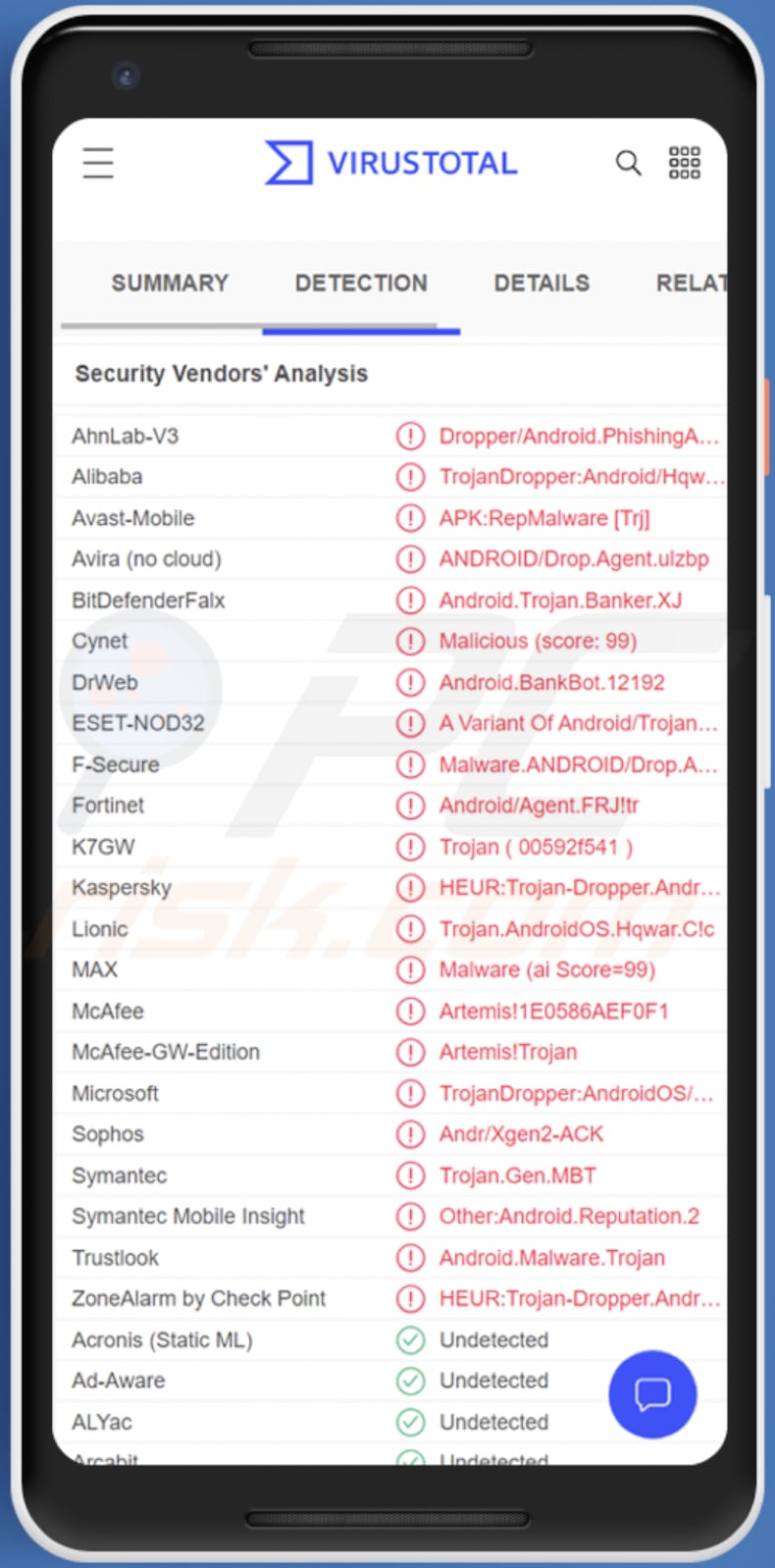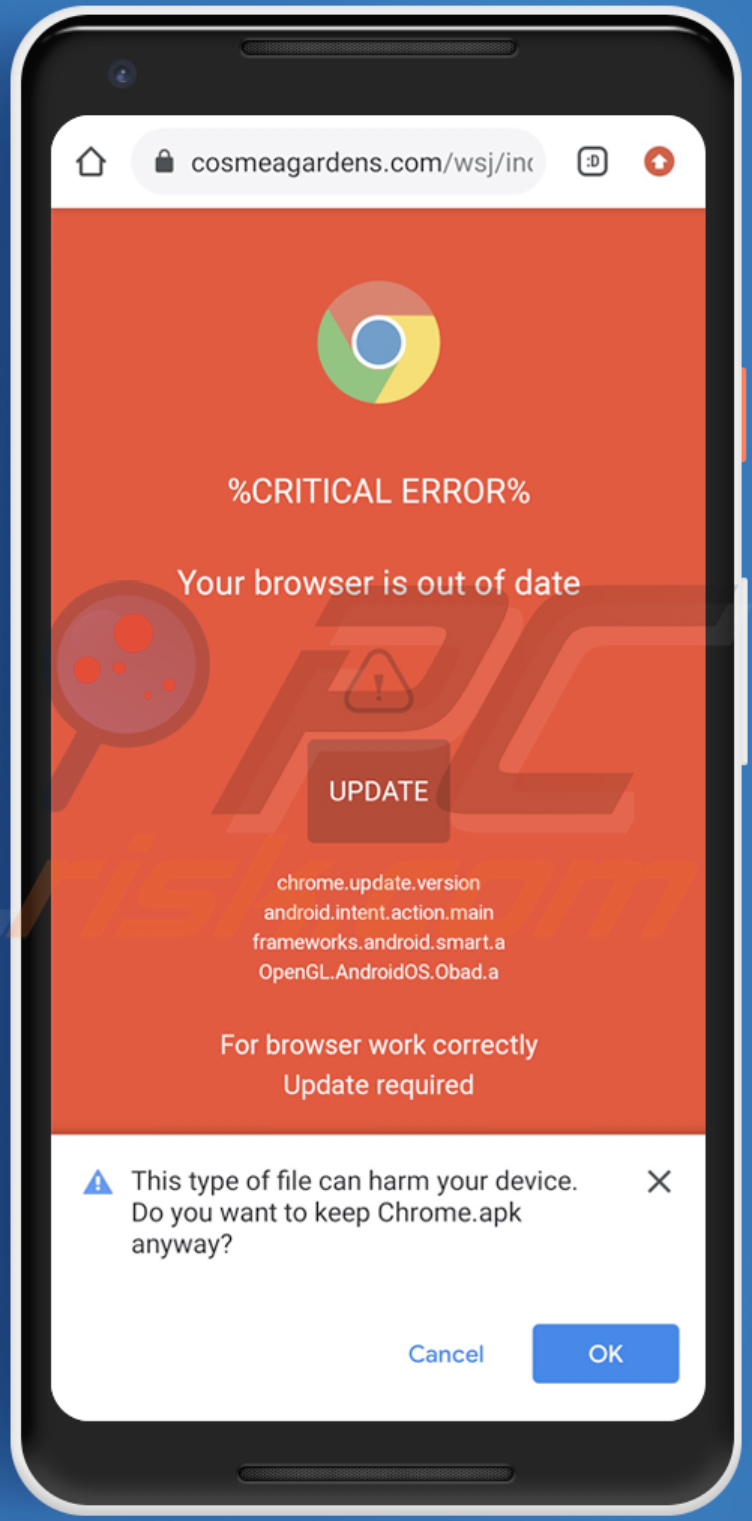Get free scan and check if your device is infected.
Remove it nowTo use full-featured product, you have to purchase a license for Combo Cleaner. Seven days free trial available. Combo Cleaner is owned and operated by RCS LT, the parent company of PCRisk.com.
What is ERMAC 2.0?
ERMAC 2.0 is the name of an Android banking Trojan targeting Polish users. We have discovered it on a hacker forum. Its developer sells it for $5000 per month. ERMAC 2.0 masquerades as a legitimate Bolt Food application. This malware steals credentials for financial and cryptocurrency applications.

More about the ERMAC 2.0 Trojan
ERMAC 2.0 can send and read SMS messages (and intercept them), send fake push notifications and read incoming notifications, muse sound and lock the screen, read messages in Gmail, view the contact list and the list of installed applications. Also, it can call certain numbers, forward calls, log keystrokes (record keyboard input).
Furthermore, ERMAC 2.0 can open a link in a web browser, clear app data, get administrator rights, kill and remove itself, block 130 antivirus applications and battery optimizers, prevent victims from deleting it, disable accessibility block, hide its icon (and change its name), collect seed phrases of crypto wallets.
| Name | ERMAC 2.0 Android malware |
| Threat Type | Android malware, malicious application, unwanted application. |
| Detection Names | Avast-Mobile (Android:Evo-gen [Trj]), BitDefenderFalx (Android.Riskware.PackMal.TD), ESET-NOD32 (A Variant Of Android/TrojanDropper.Agent.JTC), Kaspersky (HEUR:Trojan-Dropper.AndroidOS.Hqwar.ha), Full List (VirusTotal) |
| Symptoms | The device is running slow, system settings are modified without user's permission, questionable applications appear, data and battery usage is increased significantly, browsers redirect to questionable websites, intrusive advertisements are delivered. |
| Distribution methods | Fake Bolt Food website |
| Damage | Stolen personal information (private messages, logins/passwords, etc.), decreased device performance, battery is drained quickly, decreased Internet speed, huge data losses, monetary losses, stolen identity |
| Malware Removal (Windows) |
To eliminate possible malware infections, scan your computer with legitimate antivirus software. Our security researchers recommend using Combo Cleaner. Download Combo CleanerTo use full-featured product, you have to purchase a license for Combo Cleaner. 7 days free trial available. Combo Cleaner is owned and operated by RCS LT, the parent company of PCRisk.com. |
ERMAC 2.0 Trojan in general
ERMAC 2.0 can be used to hijack personal accounts, use stolen information to make fraudulent transactions (steal money), steal identities, send spam, and more. It is a powerful Android malware disguised as a legitimate Bolt Food app (and it has a fake Bolt Food download website).
More examples of Android malware are Anatsa, L3MON, and SMSControllo.
How did ERMAC 2.0 infiltrate my device?
ERMAC 2.0 is distributed using a fake Bolt Food website. It infects devices after downloading a fake Bolt Food application. As we mentioned in one of the previous paragraphs, ERMAC 2.0 can change its icon and name on the infected device. It is worth mentioning that cybercriminals can distribute trojanized apps via legitimate platforms like Google Play.
How to avoid installation of malware?
Read reviews before downloading applications (and avoid downloading apps without any or just a few reviews). Use official pages and platforms as sources for downloading apps. Do not use third-party downloaders, shady websites, and similar sources.
Also, do not trust advertisements displayed on questionable pages or click links in suspicious SMS messages (or emails).
Screenshot of the legitimate and fake websites used to distribute ERMAC 2.0 (discovered by ESET cybersecurity researchers):

ERMAC 2.0 promoted on a hacker forum:
Screenshot of a fake error message used to spread ERMAC 2.0 trojan:

Text presented within:
%CRITICAL ERROR%
Your browser is out of date
UPDATE
chrome.update.version
android.intent.action.main
frameworks.android.smart.a
OpenGL.AndroidOS.Obad.aFor browser work correctly Update required
Update October 25, 2022 - new methods observed in use for the distribution of the ERMAC 2.0 trojan. This malware is being actively proliferated via malicious sites that closely mimic legitimate ones. They can be identical in appearance and are particularly close domain-wise; the latter can differ by just one letter. This technique banks on users mistyping URLs or not sparing them more than a cursory glance.
The fake sites relate to popular software and mobile apps, cryptocurrency, social media, etc. To elaborate, ERMAC 2.0 has been spread through sites that are presented as those belonging to APKPure (fake URL - m-apkpures[.]com), Google Wallet (payce-google[.]com), PayPal (paltpal-apk[.]com), Snapchat (snanpckat-apk[.]com), TikTok download portal (tlktok-apk[.]link), VidMate (vidmates-app[.]com), and so forth.
In addition to being entered via misspelled domains, victims can be redirected to such webpages by spam mail (emails, SMSes, PMs/DMs, etc.), sites using rogue advertising networks, malicious ads, spam browser notifications, or installed adware.
Quick menu:
- Introduction
- How to delete browsing history from the Chrome web browser?
- How to disable browser notifications in the Chrome web browser?
- How to reset the Chrome web browser?
- How to delete browsing history from the Firefox web browser?
- How to disable browser notifications in the Firefox web browser?
- How to reset the Firefox web browser?
- How to uninstall potentially unwanted and/or malicious applications?
- How to boot the Android device in "Safe Mode"?
- How to check the battery usage of various applications?
- How to check the data usage of various applications?
- How to install the latest software updates?
- How to reset the system to its default state?
- How to disable applications that have administrator privileges?
Delete browsing history from the Chrome web browser:

Tap the "Menu" button (three dots on the right-upper corner of the screen) and select "History" in the opened dropdown menu.

Tap "Clear browsing data", select "ADVANCED" tab, choose the time range and data types you want to delete and tap "Clear data".
Disable browser notifications in the Chrome web browser:

Tap the "Menu" button (three dots on the right-upper corner of the screen) and select "Settings" in the opened dropdown menu.

Scroll down until you see "Site settings" option and tap it. Scroll down until you see "Notifications" option and tap it.

Find the websites that deliver browser notifications, tap on them and click "Clear & reset". This will remove permissions granted for these websites to deliver notifications. However, once you visit the same site again, it may ask for a permission again. You can choose whether to give these permissions or not (if you choose to decline the website will go to "Blocked" section and will no longer ask you for the permission).
Reset the Chrome web browser:

Go to "Settings", scroll down until you see "Apps" and tap it.

Scroll down until you find "Chrome" application, select it and tap "Storage" option.

Tap "MANAGE STORAGE", then "CLEAR ALL DATA" and confirm the action by taping "OK". Note that resetting the browser will eliminate all data stored within. This means that all saved logins/passwords, browsing history, non-default settings and other data will be deleted. You will also have to re-login into all websites as well.
Delete browsing history from the Firefox web browser:

Tap the "Menu" button (three dots on the right-upper corner of the screen) and select "History" in the opened dropdown menu.

Scroll down until you see "Clear private data" and tap it. Select data types you want to remove and tap "CLEAR DATA".
Disable browser notifications in the Firefox web browser:

Visit the website that is delivering browser notifications, tap the icon displayed on the left of URL bar (the icon will not necessarily be a "Lock") and select "Edit Site Settings".

In the opened pop-up opt-in the "Notifications" option and tap "CLEAR".
Reset the Firefox web browser:

Go to "Settings", scroll down until you see "Apps" and tap it.

Scroll down until you find "Firefox" application, select it and tap "Storage" option.

Tap "CLEAR DATA" and confirm the action by taping "DELETE". Note that resetting the browser will eliminate all data stored within. This means that all saved logins/passwords, browsing history, non-default settings and other data will be deleted. You will also have to re-login into all websites as well.
Uninstall potentially unwanted and/or malicious applications:

Go to "Settings", scroll down until you see "Apps" and tap it.

Scroll down until you see a potentially unwanted and/or malicious application, select it and tap "Uninstall". If, for some reason, you are unable to remove the selected app (e.g., you are prompted with an error message), you should try using the "Safe Mode".
Boot the Android device in "Safe Mode":
The "Safe Mode" in Android operating system temporarily disables all third-party applications from running. Using this mode is a good way to diagnose and solve various issues (e.g., remove malicious applications that prevent users you from doing so when the device is running "normally").

Push the "Power" button and hold it until you see the "Power off" screen. Tap the "Power off" icon and hold it. After a few seconds the "Safe Mode" option will appear and you'll be able run it by restarting the device.
Check the battery usage of various applications:

Go to "Settings", scroll down until you see "Device maintenance" and tap it.

Tap "Battery" and check the usage of each application. Legitimate/genuine applications are designed to use as low energy as possible in order to provide the best user experience and to save power. Therefore, high battery usage may indicate that the application is malicious.
Check the data usage of various applications:

Go to "Settings", scroll down until you see "Connections" and tap it.

Scroll down until you see "Data usage" and select this option. As with battery, legitimate/genuine applications are designed to minimize data usage as much as possible. This means that huge data usage may indicate presence of malicious application. Note that some malicious applications might be designed to operate when the device is connected to wireless network only. For this reason, you should check both Mobile and Wi-Fi data usage.

If you find an application that uses a lot of data even though you never use it, then we strongly advise you to uninstall it as soon as possible.
Install the latest software updates:
Keeping the software up-to-date is a good practice when it comes to device safety. The device manufacturers are continually releasing various security patches and Android updates in order to fix errors and bugs that can be abused by cyber criminals. An outdated system is way more vulnerable, which is why you should always be sure that your device's software is up-to-date.

Go to "Settings", scroll down until you see "Software update" and tap it.

Tap "Download updates manually" and check if there are any updates available. If so, install them immediately. We also recommend to enable the "Download updates automatically" option - it will enable the system to notify you once an update is released and/or install it automatically.
Reset the system to its default state:
Performing a "Factory Reset" is a good way to remove all unwanted applications, restore system's settings to default and clean the device in general. However, you must keep in mind that all data within the device will be deleted, including photos, video/audio files, phone numbers (stored within the device, not the SIM card), SMS messages, and so forth. In other words, the device will be restored to its primal state.
You can also restore the basic system settings and/or simply network settings as well.

Go to "Settings", scroll down until you see "About phone" and tap it.

Scroll down until you see "Reset" and tap it. Now choose the action you want to perform:
"Reset settings" - restore all system settings to default;
"Reset network settings" - restore all network-related settings to default;
"Factory data reset" - reset the entire system and completely delete all stored data;
Disable applications that have administrator privileges:
If a malicious application gets administrator-level privileges it can seriously damage the system. To keep the device as safe as possible you should always check what apps have such privileges and disable the ones that shouldn't.

Go to "Settings", scroll down until you see "Lock screen and security" and tap it.

Scroll down until you see "Other security settings", tap it and then tap "Device admin apps".

Identify applications that should not have administrator privileges, tap them and then tap "DEACTIVATE".
Frequently Asked Questions (FAQ)
What are the biggest issues that malware can cause?
Identity theft, financial losses, decreased computer performance, hijacked personal accounts, further infections, and data encryption are examples of the issues that malware can cause.
What is the purpose of ERMAC 2.0 malware?
The purpose of this Android malware is mainly to steal sensitive information. It can log keystrokes (record keyboard input), access SMS messages, steal seed phrases for cryptocurrency wallets, read messages in Gmail accounts, and more. Stolen data can be used to hijack personal accounts, steal money and identities, etc.
How did ERMAC 2.0 malware infiltrate my device?
It is known that ERMAC 2.0 is distributed using a fake Bolt Food website (a screenshot is provided below the malware description). It infects a device through a downloaded fake Bolt Food application.
Will Combo Cleaner protect me from malware?
Yes, Combo Cleaner can detect and eliminate almost all known malware. It is required to run a full scan to remove high-end malware. Typically, high-end malware hides deep in the infected system. Running a quick scan is not enough to detect it.
Share:

Tomas Meskauskas
Expert security researcher, professional malware analyst
I am passionate about computer security and technology. I have an experience of over 10 years working in various companies related to computer technical issue solving and Internet security. I have been working as an author and editor for pcrisk.com since 2010. Follow me on Twitter and LinkedIn to stay informed about the latest online security threats.
PCrisk security portal is brought by a company RCS LT.
Joined forces of security researchers help educate computer users about the latest online security threats. More information about the company RCS LT.
Our malware removal guides are free. However, if you want to support us you can send us a donation.
DonatePCrisk security portal is brought by a company RCS LT.
Joined forces of security researchers help educate computer users about the latest online security threats. More information about the company RCS LT.
Our malware removal guides are free. However, if you want to support us you can send us a donation.
Donate


▼ Show Discussion